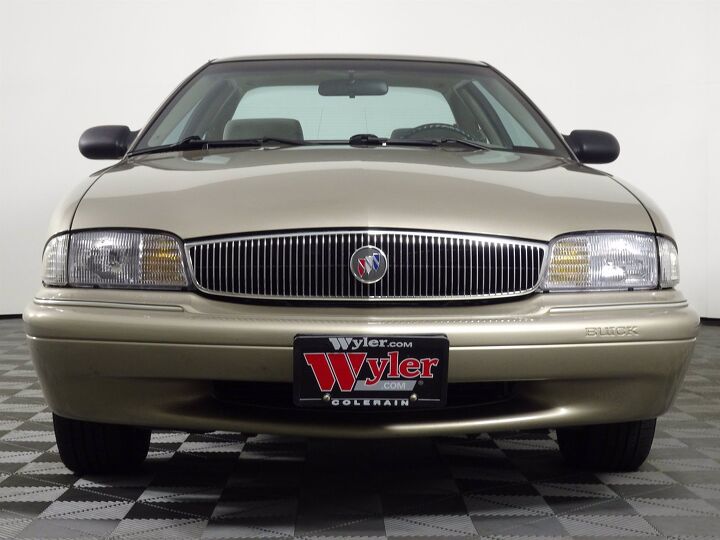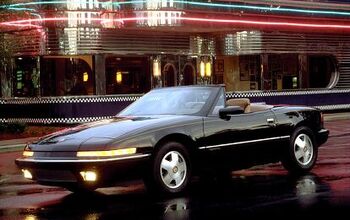Rare Rides: A Nearly-new 1997 Buick Skylark Coupe

When was the last time you saw a Nineties Skylark? More relevant to today’s subject, when did you last see one in showroom condition? The answer to the latter question is probably during the Clinton administration.
But here we are in the just wonderful year of 2020, and somehow a stunning late model Skylark has survived. Let’s take a look.
The Skylark name had a varied history at Buick. Initially, it was applied to the luxurious Roadmaster in 1953, and represented the pinnacle of the Buick brand. At its debut, Skylark was a costly and limited production convertible and joined the ranks of the Cadillac Series 62 Eldorado. The expensive model didn’t sell well, so Buick dropped Skylark after 1954 and waited until 1960 to use the name again. This time Skylark became a luxury trim on the Special compact lineup.
By the mid-Sixties Skylark graduated into a midsize car and was its own model from 1964 onward. The fun lasted until 1975 when the compact, rear-drive X-body Apollo introduced in 1973 was remodeled and split into two lines: two-doors were Skylarks, and four-doors were the Apollo. Skylark switched to the front-drive X-body in 1980 and experienced further downsizing.
Sticking with front-drive, Skylark was modernized for the 1985 model year when it transitioned to the N-body. For the first few years there were again two model names, with two-doors as Somerset Regal, and four-doors as Skylark. This was revised in 1988, when Somerset was dropped.
For 1992 a new sixth-generation Skylark arrived, though it still utilized the N-body platform. Available as coupe or sedan, The Skylark’s debut design was marked by a very sloped front end that came to a point. It was meant to hearken back to Sixties Buicks but didn’t work. It was also punctuated by an extremely early Nineties marketing campaign with an abstract painter, here:
Initial engines were not as abstract in nature, and all Skylarks were powered by either a 2.3-liter I4 or 3.3-liter V6. This was adjusted in 1994 with the arrival of a 3.1 in place of the 3.3 (both engines were 160 horsepower). Further engine revisions for 1995 saw the 2.3-liter Quad 4 change from SOHC to DOHC, which increased power from 120 to 150 horses. Until 1995 only a three-speed automatic was available, but a four-speed arrived that year as an optional extra on the four-cylinder and standard on the V6.
Toward the end of its life, the Skylark was refreshed away from its artistic and pointy look. The entirety of the front clip was softened and took on a more Century-like appearance. Likely this meant 96-onward Skylarks were less subjected to parking lot bumps at the front – no more pointy protrusion. The hood was also reshaped and smoothed to ditch its power bulge. Other changes that year included the replacement of the 2.3-liter engine with a 2.4 of the same 150 horsepower. The three-speed was finally discontinued for ’96.
The final year Skylark was sold to consumers was 1997, as minimal changes marked the model’s permanent exit from the Buick lineup. The coupe was canceled for Skylark’s final year in 1998, as the sedan was relegated solely to fleet order status. Buick didn’t think that its image was in line with the compact car segment anymore, and steered clear until the Verano’s introduction in 2012.
Today’s very late Custom (base) trim Skylark was purchased in Pennsylvania in March of 1997 and passed to its second owner in December 2019 with 4,970 miles on the odometer. The second owner drove about 10,000 miles in eight months and then traded it off to a Nissan dealer in Cincinnati. This V6-equipped beauty is yours for $5,995.
[Images: seller, Buick]

Interested in lots of cars and their various historical contexts. Started writing articles for TTAC in late 2016, when my first posts were QOTDs. From there I started a few new series like Rare Rides, Buy/Drive/Burn, Abandoned History, and most recently Rare Rides Icons. Operating from a home base in Cincinnati, Ohio, a relative auto journalist dead zone. Many of my articles are prompted by something I'll see on social media that sparks my interest and causes me to research. Finding articles and information from the early days of the internet and beyond that covers the little details lost to time: trim packages, color and wheel choices, interior fabrics. Beyond those, I'm fascinated by automotive industry experiments, both failures and successes. Lately I've taken an interest in AI, and generating "what if" type images for car models long dead. Reincarnating a modern Toyota Paseo, Lincoln Mark IX, or Isuzu Trooper through a text prompt is fun. Fun to post them on Twitter too, and watch people overreact. To that end, the social media I use most is Twitter, @CoreyLewis86. I also contribute pieces for Forbes Wheels and Forbes Home.
More by Corey Lewis
Latest Car Reviews
Read moreLatest Product Reviews
Read moreRecent Comments
- Jeff Not bad just oil changes and tire rotations. Most of the recalls on my Maverick have been fixed with programming. Did have to buy 1 new tire for my Maverick got a nail in the sidewall.
- Carson D Some of my friends used to drive Tacomas. They bought them new about fifteen years ago, and they kept them for at least a decade. While it is true that they replaced their Tacomas with full-sized pickups that cost a fair amount of money, I don't think they'd have been Tacoma buyers in 2008 if a well-equipped 4x4 Tacoma cost the equivalent of $65K today. Call it a theory.
- Eliyahu A fine sedan made even nicer with the turbo. Honda could take a lesson in seat comfort.
- MaintenanceCosts Seems like a good way to combine the worst attributes of a roadster and a body-on-frame truck. But an LS always sounds nice.
- MRF 95 T-Bird I recently saw, in Florida no less an SSR parked in someone’s driveway next to a Cadillac XLR. All that was needed to complete the Lutz era retractable roof trifecta was a Pontiac G6 retractable. I’ve had a soft spot for these an other retro styled vehicles of the era but did Lutz really have to drop the Camaro and Firebird for the SSR halo vehicle?











































Comments
Join the conversation
Was never a fan of the N-Bodies but have to admit, I'm surprised at the number of Grand Ams, in particular, I see still soldiering on in the land where 90s vehicles don't die.
A simpler time for sure and one had so many choices that are completely lacking today. We sold a pile of these little N-body cars and besides the normal high mileage neglected 3100 intake issues were pretty decent cars for the lower cost commuter. I spent a good amount of time in a green 4 door 1997 Skylark with the 3100 and was impressed how smooth and zippy that engine was and the mileage was impressive with one long trip seeing nearly 38 MPG! The fact we still see these in the salt belt of Upstate, NY says a lot.